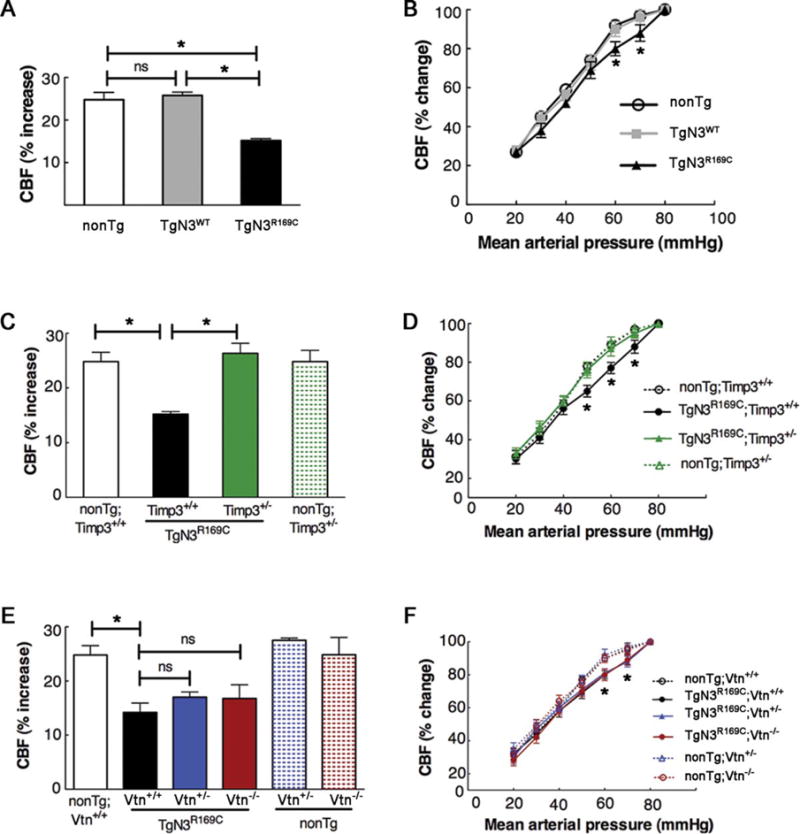FIGURE 2.

Timp3 haploinsufficiency protects against attenuated functional hyperemia and altered cerebral blood flow (CBF) autoregulation in TgNotch3R169C mice, whereas genetic reduction or ablation of vitronectin has no effect. CBF changes evoked by whisker stimulation (functional hyperemia; A, C, E) and controlled mean arterial pressure (MAP) reduction (B, D, F) were assessed in various 6-month-old transgenic mouse models (n = 5–8 males per genotype). (A, B) Single transgenic TgNotch3R169C (TgN3R169C) and TgNotch3WT (TgN3WT) mice, and nontransgenic (nonTg) littermate controls. (C, D) Double-mutant TgN3R169C; Timp3+/− mice, with Timp3 haploinsufficiency in the context of Notch3R169C overexpression; nonTg;Timp3+/+, nonTg;Timp3+/−, and TgNotch3R169C;Timp3+/+ mice were included as controls. (E, F) Double-mutant TgN3R169C;Vtn+/− and TgN3R169C;Vtn−/− mice, with vitronectin haploinsufficiency and complete ablation, respectively, in the context of Notch3R169C overexpression; non-Tg;Vtn+/+, nonTg;Vtn+/−, nonTg;Vtn−/−, and TgNotch3R169C;Vtn+/+ mice were included as controls. Functional hyperemia was strongly attenuated in TgN3R169C mice compared to TgN3WT and nonTg littermate mice, and TgN3R169C mice showed an impaired relationship between CBF and MAP; CBF was significantly different between TgN3R169C and TgN3WT or nonTg mice at MAP values of 60 to 70mmHg. CBF responses were similarly impaired in TgN3R169C mice expressing wild-type Timp3 (TgN3R169C;Timp3+/+) or wild-type vitronectin (TgN3R169C;Vtn+/+), whereas these responses were not altered in nonTg littermate mice with or without genetic reduction of Timp3 (nonTg;Timp3+/−) or vitronectin (nonTg;Vtn−/−). Importantly, TgN3R169C;Timp3+/− mice exhibited normalized CBF responses to whisker stimulation and a restored relationship between MAP and CBF comparable to that of their nonTg;Timp3+/− and nonTg;Timp3+/+ littermates (C, D). In contrast, neither TgN3R169C;Vtn+/− nor TgN3R169C;Vtn−/− mice (E, F) exhibited improved CBF responses. (A, C, E) One-way analysis of variance (ANOVA) followed by Tukey post hoc test; (B, D, F) 2-way repeated measures ANOVA followed by Bonferroni post hoc test (*p < 0.05). The main physiological variables for all mice are presented in the Table. ns = nonsignificant.
